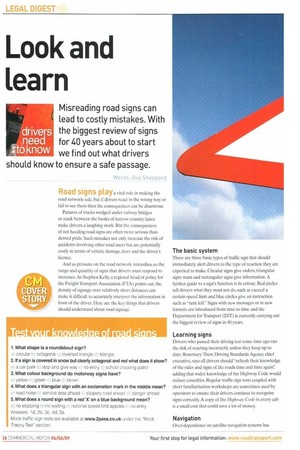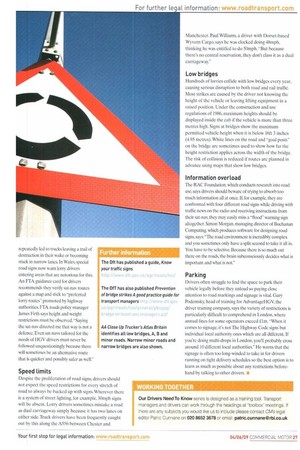Look and Learn
Page 26

Page 27

If you've noticed an error in this article please click here to report it so we can fix it.
Misreading road signs can lead to costly mistakes. With the biggest review of signs for 40 years about to start we find out what drivers should know to ensure a safe passage.
Words: Guy Sheppard Koaci signs play a vital role in making the
road network safe, but if drivers react in the wrong way or fail to see them then the consequences can be disastrous.
Pictures of trucks wedged under railway bridges or stuck between the banks of narrow country lanes make drivers a laughing stock. But the consequences of not heeding road signs are often more serious than dented pride. Such mistakes not only increase the risk of accidents involving other road users but are potentially costly in terms of vehicle damage, tines and the driver's licence.
And as pressure on the road network intensifies, so the range and quantity of signs that drivers must respond to increases. As Stephen Kelly, a regional head of policy for the Freight Transport Association (FTA) points out, the density of signage over relatively short distances can make it difficult to accurately interpret the information in front of the driver. Here are the key things that drivers should understand about road signage.
The basic system
There are three basic types of traffic sign that should immediately alert drivers to the type of reaction they are expected to make. Circular signs give orders, triangular signs warn and rectangular signs give information. A further guide to a sign's function is its colour. Red circles tell drivers what they must not do, such as exceed a certain speed limit and blue circles give an instruction such as "turn left': Signs with new messages or in new formats are introduced from time to time and the Department for Transport (MT) is currently carrying out the biggest review of signs in 40 years.
Learning signs
Drivers who passed their driving test some time ago run the risk of reacting incorrectly unless they keep up to date. Rosemary Thew, Driving Standards Agency chief executive, says all drivers should "refresh their knowledge of the rules and signs of the roads time and time again': adding that wider knowledge of the Highway Code would reduce casualties. Regular traffic sign tests coupled with short familiarisation workshops are sometimes used by operators to ensure their drivers continue to recognise signs correctly. A copy of the Highway Code in every cab is a small cost that could save a lot of money.
Navigation
Over-dependence on satellite navigation systems has repeatedly led to trucks leaving a trail of destruction in their wake or becoming stuck in narrow lanes. In Wales, special road signs now warn lorry drivers entering areas that are notorious for this. An FTA guidance card for drivers recommends they verify sat-nay routes against a map and stick to "preferred lorry routes" promoted by highway authorities. PTA roads policy manager James Ftrth says height and weight restrictions must be observed. "Saying the sat-nay directed me that way is not a defence. Even sat-navs tailored for the needs of HGV drivers must never be followed unquestioningly because there will sometimes be an alternative route that is quicker and possibly safer as well."
Speed limits
Despite the proliferation of road signs, drivers should not expect the speed restrictions for every stretch of road to always he backed up with signs. Wherever there is a system of street lighting, for example, 3Ornph signs will be absent. Lorry drivers sometimes mistake a road as dual carriageway simply because it has two lanes on either side. Truck drivers have been frequently caught out by this along the A556 between Chester and Manchester. Paul Williams, a driver with Dorset-based Wyvern Cargo. says he was clocked doing 48mph, thinking he was entitled to do 50mph. "But because there's no central reservation, they don't class it as a dual carriageway."
Low bridges
Hundreds of lorries collide with low bridges every year, causing serious disruption to both road and rail traffic. Most strikes are caused by the driver not knowing the height of the vehicle or leaving lifting equipment in a raised position. Under the construction and use regulations of 1986, maximum heights should be displayed inside the cab if the vehicle is more than three metres high. Signs at bridges show the maximum permitted vehicle height when it is below 16ft 3 inches (4.95 metres). White lines on the road and -goal posts" on the bridge are sometimes used to show how far the height restriction applies across the width of the bridge. The risk of collision is reduced if routes are planned in advance using maps that show low bridges.
Information overload
The RAC Foundation, which conducts research into road use, says drivers should beware of trying to absorb too much information all at once. If, for example, they are confronted with four different road signs while driving with traffic news on the radio and receiving instructions from their sat-nay, they may easily miss a -flood" warning sign altogether. Simon Morgan, managing director of Buchanan Computing, which produces software for designing road signs, says: "The road environment is incredibly complex and you sometimes only have a split second to take it all in. You have to be selective. Because there is so much out there on the roads, the brain subconsciously decides what is important and what is not."
Parking
Drivers often struggle to find the space to park their vehicle legally before they unload so paying close attention to road markings and signage is vital. Gary Podemsky, head of training for AdvantageHGV, the driver training company, says the variety of restrictions is particularly difficult to comprehend in London, where annual fines for some operators exceed Lim. "When it comes to signage, it's not The Highway Code signs but individual local authority ones which are all different. If you're doing multi-drops in London, you'll probably cross around 10 different local authorities." He warns that the signage is often too long-winded to take in for drivers running on tight delivery schedules so the best option is to learn as much as possible about any restrictions beforehand by talking to other drivers. •
















































































































































